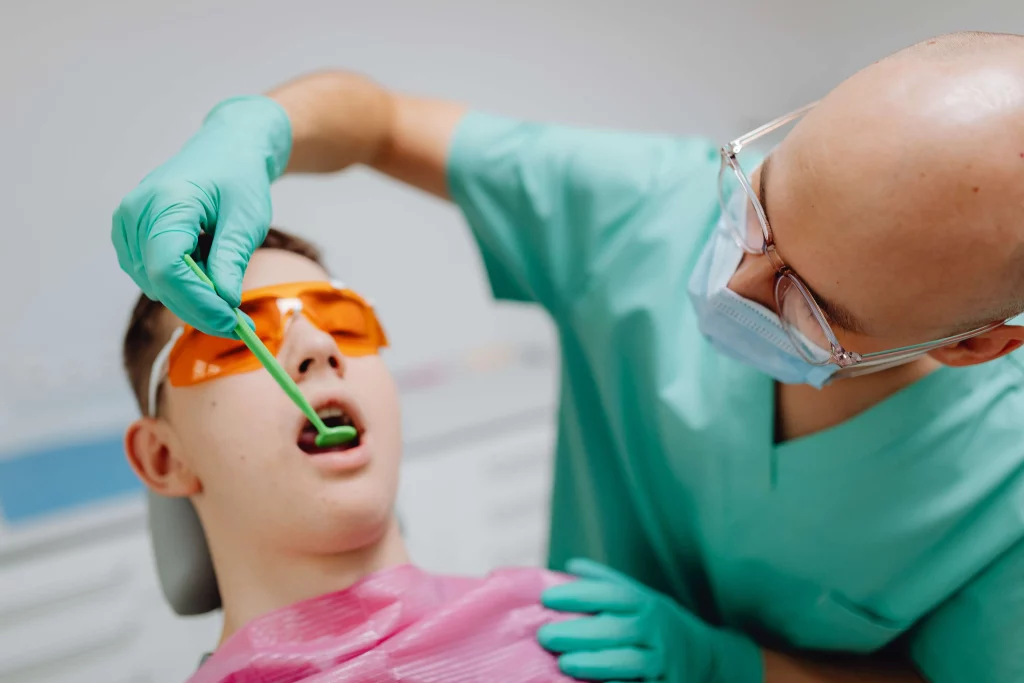Oral Diseases and Treatments: Herpes Lesions
Dental and oral health is essential for your overall health and well-being. However, some people just don’t seem to consider it as essential as they would consider taking care of their other body parts. That’s often why even a minor symptom becomes a full-fledged oral disease.
Oral Diseases
Oral diseases are a group of conditions that affect the mouth and throat. These conditions affect the mouth and its surrounding structures and can be divided into two groups:
- Primary oral diseases include gum disease, periodontal disease (disease of the gum tissue), tooth decay, and oral cancer.
- Secondary oral diseases include cold sores or fever blisters on the lips or tongue, dry mouth (xerostomia), halitosis (bad breath) from poor dental hygiene, stomatitis (inflammation of the mucous membranes in the mouth) from an allergy to a food or drink, and fungal infections such as thrush (oral candidiasis).
Herpes lesions are small, raised bumps that appear on the skin. They are caused by the herpes simplex virus (HSV) and can be painful. The most common type of herpes is called HSV-1, which causes cold sores or fever blisters. In some people, however, HSV-2 may cause genital herpes.
Genital herpes is a sexually transmitted disease (STD). It occurs when you have contact with someone with an active infection of either type of HSV in their mouth or genitals. Herpes on the mouth is a common infection that causes sores or blisters in the mouth.
It can be spread through kissing and oral sex. Herpes on the lips and gums are called cold sores (herpes labialis). Herpes on the tongue is called herpes simplex of the tongue (HSVT). HSV-1 usually infects only one side of your mouth, while HSV-2 can affect both sides of your mouth.
Oral disease treatment is for conditions such as gingivitis and periodontal disease. Treatment may involve a combination of medications, surgical procedures, and other therapies, including dental hygiene measures. Oral disease treatment may be necessary to prevent further damage to the teeth or bone structures in the mouth.
Some signs of an oral infection include redness around your gums, bad breath (halitosis), swelling under your tongue (gingival hypertrophy), bleeding when you brush or floss, pain chewing food or speaking, tooth decay, and loosening.
The American Dental Association recommends that adults visit their family dental and oral healthcare experts every six months for routine cleanings and checkups. So if you notice any of the following symptoms, schedule your appointment right away:
- Pain or tenderness in your gums or mouth
- Red or swollen gums
- Bad breath
APHTHAE
Aphthae is a skin condition that causes small, painful ulcers on the lips and around the mouth. It can also cause pain in the gums or inside the cheeks. Aphthae usually appear as red bumps or sores that are often filled with pus. The sores may be very itchy and bleed easily. They may also look like acne lesions, but the particular acne infection does not cause them.
The exact cause of aphthae is unknown, but some things are denoted as a secondary reason for causing aphthae, including:
- Infections (bacterial, viral, or fungal) cause an overgrowth of the skin’s normal bacteria. This causes an inflammatory response in the area and may lead to swelling and redness. The inflammation can be severe enough to break through the skin barrier and cause bleeding underneath.
- Skin conditions such as eczema or psoriasis result in skin thickening with increased friction between it and clothing or bedding.
- Inflammatory diseases such as rheumatoid arthritis (RA), lupus erythematosus (SLE), etc.
The treatment for aphthae depends on the type of infection. Some types of infections can be treated with antibiotics, and others require surgery to remove them from your body. For example, if you have a bacterial infection, your doctor will prescribe an antibiotic to kill the bacteria and treat any secondary infections. If you have a fungal infection, your doctor will prescribe antifungal drugs or creams to treat it.
The American Dental Association recommends that adults visit their family dental and oral healthcare experts every six months for routine cleanings and checkups. So if you notice any of the following symptoms, schedule your appointment right away:
- Pain or tenderness in your gums or mouth
- Red or swollen gums
- Bad breath
Lichen Planus
Lichen Planus is a skin condition that causes itchy, red, and scaly patches on the skin. It occurs when the body’s immune system attacks healthy tissue in the skin. The symptoms of Lichen Planus can vary from person to person, but they usually include:
- Red or pinkish-red flat lesions (patches) on your hands and feet with small white bumps at their centers. You may also experience swelling of the affected area.
- Sores don’t heal for more than two weeks after you first notice them. These sores may be individual or multiple. They may also appear as raised areas with a bumpy texture.
- Painful skin lesions may appear anywhere on the body, especially in the groin or armpits. The lesions can be red and raised, but they do not blister. They also tend to itch and burn. In some cases, there is a rash with blisters or small bumps (papules).
- Redness or swelling of the skin that does not go away after several days.
- Itching in areas where you have painless skin changes (such as your face near your mouth).
- A mild fever for no apparent reason.
The exact cause of lichen planus is unknown. Some people with lichen planus have a family history of the condition, and some develop it after an infection or injury to the skin. The immune system may be involved in causing lichen planus, but other factors also play a role.
Treatment for lichen planus is based on the severity of symptoms. If you have mild symptoms, your doctor may recommend taking a non-steroidal anti-inflammatory drug (NSAID) such as ibuprofen or naproxen (Aleve). You can also use corticosteroid cream to relieve itching and pain.
If your symptoms are more severe, you may need to take an oral steroid medicine called prednisone. This medication will help reduce inflammation in the skin that causes the rash. It can also help decrease inflammation in other parts of your body if it’s not causing any problems.
The American Dental Association recommends that adults visit their family dental and oral healthcare experts every six months for routine cleanings and checkups. So if you notice any of the following symptoms, schedule your appointment right away:
- Pain or tenderness in your gums or mouth
- Red or swollen gums
- Bad breath
Hemangioma
Hemangioma is a benign tumor that develops in the blood vessels of the skin, bone, and other organs. It is also known as capillary hemangioma or venous malformation. Hemangiomas often occur on the face, neck, and scalp but can also be found anywhere else on the body. Hemangiomas can occur at any age, but they are most common in children between 1 month and five years of age. They may also occur later in life, especially after puberty.
The tumors are usually red or purple and may have a slightly raised surface texture. They can range from small to large, with some being large (up to one inch). Most hemangiomas are not painful but can become itchy if scratched, leading to secondary infection. Also, they mainly affect only one area of the body. However, some hemangiomas spread to other parts of your body too.
Symptoms of hemangioma can vary but often include:
- Pain in the affected area. It may be mild or severe and can be constant or intermittent. The pain is usually felt in the upper body or lower abdomen as the body weakens against the disease.
- Itching around the affected area that does not respond to scratching.
- Swelling of the skin overlying a hemangioma (the redness may look like a bruise).
- Red streaks, along with swelling and itching on one side of the face (usually on one side only), are caused by blood vessels growing into an abnormal part of your body tissue, causing it to swell up and lead to inflammation.
As we mentioned earlier, hemangioma is caused by a buildup of blood vessels in the skin. This is called angiogenesis. It occurs when new blood vessels grow into the skin to supply it with nutrients or oxygen. So these are usually benign growths. However, they can become cancerous if they grow too large or invade deeper tissues like muscle, bone, or nerves.
Unfortunately, there is not one specific cure for hemangiomas. Hence, treatment may be considered according to the patient’s case. It may involve removing the tumor and covering it with a bandage or dressing to prevent scarring. This treatment is often done in conjunction with surgery to remove the tumor. Surgery may also be recommended if other underlying conditions, such as an abnormal blood vessel, can cause bleeding into the hemangioma.
The American Dental Association recommends that adults visit their family dental and oral healthcare experts every six months for routine cleanings and checkups. So if you notice any of the following symptoms, schedule your appointment right away:
- Pain or tenderness in your gums or mouth
- Red or swollen gums
- Bad breath
Fungal Diseases in Mouth
Oral Candidiasis Infection- Oral Thrush
Oral candidiasis, often known as oral thrush, is a disorder where Candida albicans build up on the mouth’s lining. Creamy white lesions are a symptom of oral thrush, often appearing on the tongue’s surface or inner cheeks. Oral thrush can occasionally spread to the throat, tonsils, gums or back. Although anybody can have oral thrush, it is more common in newborns and older adults due to their weakened immune systems and in other people with weakened immune systems, specific medical problems or those who take drugs. Oral thrush is a minor issue if you have a strong immune system, but if you do not, symptoms might be more severe and unmanageable.
Most oral fungal infections, also known as oral mycosis, are brought on by opportunistic diseases. The onset and development of pathogenic conditions are made possible by local colonization in the oral cavity due to host resistance deficiency.
With the expanded use of immuno-suppressive medications and the prevalence of HIV infections, the incidence of mycosis has noticeably grown worldwide.
The oral tissues can get infected with fungi on a superficial or deep level. Candidiasis infections that infect the oral tissues superficially are most commonly identified and reported.
Although various strains of Candida may infect the oral mucosa, Candida albicans is the one that causes the majority of oral fungal infections and may be particularly contagious due to its higher degree of pathogenicity and adhesion properties. Between 40% and 65 percent of the mouth of healthy adults contain C. Albicans as an oral pathogen. Preferential reservoir regions include the papillated dorsal side of the tongue and the palatal mucosa under a maxillary prosthetic denture.
A vulnerable host is nearly always implicated with oral candidiasis, either locally or systemically. Local variables include reduced saliva production and denture weaning. AIDS, diabetes mellitus, and pernicious anemia are examples of systemic causes. Women and the elderly are moderately at higher risk for candida infections.
The host’s immune system may also be suppressed by the C. Albicans infection itself.
Oral candidiasis, often known as oral thrush, is a disorder where Candida albicans build up on the mouth’s lining. Although Candida is a typical oral microorganism, it can occasionally overgrow and produce symptoms.
Creamy white lesions are a symptom of oral thrush, often appearing on the tongue’s surface or inner cheeks. Oral thrush can occasionally spread to the throat, tonsils, gums, or back.
Although anybody can have oral thrush, it’s more common in newborns and older adults due to their weakened immune systems and in other people with weakened immune systems, specific medical problems, or those who take particular drugs.
Oral thrush is a minor issue if you have a strong immune system, but if you don’t, symptoms might be more severe and unmanageable.
Many mothers are concerned about developing or passing on thrush during nursing since infants are more vulnerable to it. It’s a typical issue with breastfeeding, and the solution might be challenging in certain circumstances.
Thrush-infected infants can infect their moms. When a baby’s oral infection causes a sore throat and discomfort, they scream and get agitated when being fed. Fungal infections all around breasts and nipples can also develop in mothers (mainly if they are on antibiotics) and be transmitted to their offspring.
To stop the infection from spreading further between the mother and the child, thrush should be treated as soon as it manifests.
Oral Fungal infections are difficult to comprehend in the early stages. However, it’s essential to visit your dental health practitioner as soon as you observe the following symptoms:
- The tongue, inner lining of cheeks, and occasionally upper palate of mouth, tonsils, and gums will all develop cream-colored lesions.
- Lesions that look like cottage cheese and are somewhat thickened.
- Erythema, blistering, or discomfort that could be so bad that it makes it difficult to swallow or eat.
- Lesions tend to bleed if scraped or rubbed.
- The corners of your mouth may be cracked and irritated.
- Having a cottony mouthfeel.
- Loss of taste.
- Denture stomatitis is often characterized as redness, inflammation, and discomfort under dentures.
- The long, muscular tube that runs from the back of your mouth to your stomach, known as the esophagus, may get infected with lesions in severe instances, which are typically brought on by cancer or an immune system that HIV/AIDS has compromised.
- If this happens, you can have soreness in your throat, painful swallowing, or the feeling that food is becoming trapped there.
Infants may struggle to eat or be fussy and agitated, in addition to the noticeable white mouth sores. While nursing, they might spread the virus to the mother.
- These indications and symptoms may appear in females with candida-infected breasts:
- Nipples that are sensitive, unusually red, cracked, or scratchy.
- The darker, circular ring surrounding the nipple has shiny or dry skin (areola).
- Unusual discomfort when breastfeeding.
- Deep stabbing pain in and around the breast.
Antifungal drugs are frequently used to treat oral candidiasis. An antifungal medication is often administered to the mouth’s interior for a week or two as a therapy for mild to moderate fungal infections. The drug of choice can be nystatin, miconazole, or clotrimazole. Fluconazole is an antifungal drug that may be administered orally or intravenously and is the most typical therapy for severe infections.
Medical professionals could prescribe a new antifungal medication if the patient does not improve after taking fluconazole. Fluconazole is typically used to treat esophageal candidiasis. Alternative prescription antifungal medications are also an option for those who are intolerant to fluconazole or who do not improve with it.
To cure oral thrush or prevent a recurrence, your doctor may also suggest lifestyle modifications or at-home therapies.
It’s critical to maintain appropriate dental hygiene as you heal. Here are some pointers:
- To prevent scratching the lumps brought on by thrush, it is better to use a soft toothbrush when brushing your teeth.
- If you use dentures, thoroughly clean them after each use to reduce the risk of reinfection.
- Change your toothbrush once the treatment is complete.
- If your doctor hasn’t recommended mouthwash or oral spray, stay away from them.
- Rinsing your mouth with salt water, baking soda solution, lemon, and water, or water and apple cider vinegar may be helpful, too.
- Additionally, a probiotic pill or consuming yogurt enriched with healthy bacteria can help.
Oral Cavity Cancer
Oral Cavity Cancer is generalized as the carcinogenic growth of tumors in the oral cavity that can affect the lips, tongue, cheek, upper or lower palate and throat. When it manifests as white spots or bleeding sores around the lips or mouth, oral cancer might appear to be a common disease. The fact that these abnormalities resurface sets suspected cancer apart from inherent mouth diseases like ulcers or inflammation. If oral cancer is not treated, it can spread from your oral cavity to other parts of your neck and head.
Oral Cavity Cancer is generalized as the carcinogenic growth of tumors in the oral cavity that can affect the lips, tongue, cheek, upper or lower palate, and throat.
When it manifests as white spots or bleeding sores around the lips or mouth, oral cancer might appear to be a common disease. The fact that these abnormalities resurface sets suspected cancer apart from inherent mouth diseases like ulcers or inflammation.
If oral cancer is not treated, it can spread from your oral cavity to other parts of your neck and head. Around 63% of oral cavity cancer patients live five years after being diagnosed.
The TNM method is used to stage oral carcinoma. T stands for the primary tumor’s size and position. N signifies that the malignancy has progressed to your lymph nodes. M stands for metastasis, or when cancer has spread to other body parts.
Oral cavity cancer has the following stages:
TI: The growth in your mouth is no more than 2 millimeters.
T2: The tumor is no greater than 4 centimeters in diameter and is 2 cm or smaller.
T3: The tumor is beyond 4 cm in size.
According to the American Cancer Society, men are twice as likely as women to acquire oral cancer.
Here are the risk factors for developing oral cavity cancer:
Smoking. Smokers of cigarettes, cigars, or pipes are considerably more likely to acquire mouth cancer than nonsmokers.
Tobacco products. Cheeks, gums, and lip lining malignancies are 50 times more incidents among chewing, snuff, or dip tobacco users.
Excessive alcohol consumption. Alcoholics experience oral malignancies roughly six times more frequently than nondrinkers. Combining cigarettes and alcohol further raises your odds.
Have a family history. If cancer runs in the family and an is exposed to other risk factors, they are highly likely to acquire major or minor carcinomas.
Human papillomavirus. Oropharyngeal squamous cell carcinoma is etiologically associated with certain HPV strains. Most people who engage in sexual activity will eventually get HPV.
A sub-type of this virus produces malignancies in the back of men’s mouths and throats through oral sexual activity. The risk increases if you come in contact with multiple partners.
Age. The growth of oral malignancies might take years. It is often discovered after the age of 55. However, malignancies connected to HPV are developing in more young males.
Gender. Oral cancer strikes men at least twice as frequently as it strikes women. It could be the case that males smoke and drink more than women.
You must seek immediate medical attention if oral cancer symptoms that extend longer than two weeks. Here’s what you should look out for:
- The mouth or throat feels thick, irritated, or painful.
- A visible red or white spot inside your mouth
- Feeling as though your neck is being squeezed
- Coughing that won’t stop
- Any voice change, such as hoarseness
- Swallowing, chewing, or speaking difficulties
- Tingling in the mouth
- Having trouble moving your mouth or jaw
- Recurrent nosebleeds
- Ear ache that is not associated with hearing loss
- Inflammation in the neck or jaw
- Unexpected weight loss
The following tests may be used to diagnose oral cancer in a thorough clinical examination:
Biopsy
Samples of tissue are taken from the body during a biopsy operation. They are examined under a microscope by a pathologist to check for the presence of cancerous or other abnormal growth. Biopsies are typically taken from the mouth region while the patient is under local anesthetic. A needle is often used to draw samples from the lymph glands around the throat.
Endoscopy
A miniature fiber-optic lens is placed further into the mouth to inspect the throat for symptoms of malignancy.
MRI or CT-Scan
These non-invasive methods use images in your body to find anomalies not seen on a regular X-ray.
Ultrasonography
It is a non-invasive method for generating a view of the interior organs using sound waves of high frequency. Ultrasound could be used to check or take samples from the neck lymph nodes in cases of mouth cancer.
PET Scan
It is a non-invasive method that makes use of unique radioactive dyes that might be used to find cancer in the body.
Prior to developing a treatment strategy, cancer must first be staged (to ascertain its extent) when a diagnosis has been made. Your doctor will assess which tests are necessary for your case.
The three primary forms of treatment for oral cancer are radiation, surgery, and chemotherapy. You may probably require one form of therapy or a mix of therapies.
The interdisciplinary board of oncologists, including the medical oncologists, head and neck surgeons, speech-language oncologists, and radiation oncologists, sit together to devise a treatment plan.
Here are the treatment options:
Surgery
Depending on the tumor’s position, size, and spread, several surgical procedures can be used during oral cancer surgery. You could require surgery to remove oral cancer and repair your mouth once excised. If there is a chance that cancer has progressed to your neck lymph nodes, the surgeon might remove them too.
Radiation Therapy
High-frequency rays are used in radiation treatment to destroy cancer cells and limit cancer progression. Radiation treatment is highly focused and only targets the region that has cancer. This treatment is often done externally by a device but can also be provided internally via radioactive substances.
Chemotherapy
Chemo kills cancer cells by delivering drugs through an intravenous route of administration. Chemotherapy can be administered independently or in conjunction with radiation treatment or surgery.
Immunotherapy
Immunology makes use of drugs to strengthen your body’s defenses against cancer. Patients with metastatic oral malignancies who are not responsive to conventional therapy may be prescribed.
Cell-Targeted Treatments
Some people may benefit from medications that specifically target cancer cells. Cetuximab, which targets the receptors for epidermal growth factor, is one such.
SYSTEMIC DISEASES
Many dental treatments are quite straightforward and come with minimal complications if performed properly. However, many people suffer from systemic health conditions that could make the treatment more complicated. Systemic diseases could greatly interfere with even the simplest of dental procedures. Therefore, it is important for a dentist to thoroughly examine the patient and possibly get clearance from their doctors as well before getting treatment.
Heart Disease
In some patients with heart disease, endocarditis prophylaxis is necessary before treatment. Patients with prosthetic valves, history of bacterial endocarditis, treated congenital conditions and patients with transplants usually require prophylaxis.
Blood Disorders
People with blood disorders that can cause problems with blood coagulation should get clearance by their doctors before getting dental treatment as well. Sometimes they need to take extra medication in the form of clotting factors. Even anesthesia needs to be administered carefully to patients with blood disorders to ensure that the site of anesthesia heals properly.
Cancer
If the patient has a tumor in their mouth, a tooth extraction close to that site could allow the tumor to invade other areas of the mouth, such as the tooth socket. Therefore, dental procedures on people with cancers should only be performed when they are being treated effectively. Other than that, cancers of the blood may prevent proper healing during a dental treatment as well.
Endocrinal concerns
People with endocrinal disorders such as diabetes will have to alter their medications and get cleared by their doctors before getting invasive treatments. People with other conditions such as hypothyroidism will also need clearance or alternative forms of anesthesia to make the procedure painless.
Epilepsy
People with epilepsy or other neurological conditions that can cause regular seizures will have to have treatment in environments that do not trigger their seizures. Other than that, people with
Epilepsy should also only be given fixed dental appliances that cannot be swallowed during an episode.
Immunosuppressive Conditions
Good immunity is of utmost importance during treatment. A patient with compromised immunity, such as those of people suffering from HIV and AIDS will be at a very high risk of developing infections during dental treatment. Kaposi’s Sarcoma, hairy leukoplakia, candidiasis and some ulcers are common complications of dental procedures.
Drugs
Certain drugs interfere with dental treatments or with the healing process after dental treatments. Common complications include dry mouth, especially in older patients. Drugs that prevent effective blood clotting such as NSAIDS or aspirin should also be stopped before dental treatments. Lastly, people taking drugs that cause gingival hyperplasia should also be stopped before treatment.





